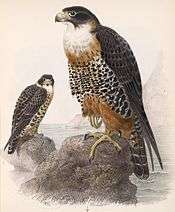Orange-breasted falcon
The orange-breasted falcon (Falco deiroleucus) is a bird of the falcon family. It is probably closely related to and looks like a larger version of the bat falcon. These two, in turn, are probably closest to the aplomado falcon and constitute a rather old American lineage of Falco.[2]
| Orange-breasted falcon | |
|---|---|
| at Chapada dos Guimarães, Mato Grosso State, Brazil | |
| Scientific classification | |
| Kingdom: | Animalia |
| Phylum: | Chordata |
| Class: | Aves |
| Order: | Falconiformes |
| Family: | Falconidae |
| Genus: | Falco |
| Species: | F. deiroleucus |
| Binomial name | |
| Falco deiroleucus Temminck, 1825 | |
It is found from southern Mexico to northern Argentina. It's a medium-sized falcon at 35–40 cm (14–15.5 in) long and a weight of 325–700 grams (11 ounces–1 pound 9 ounces).[3] It is a bird predator, with strong talons that enable it to catch prey in flight, and is considered by some – such as the German-Brazilian ornithologist Helmut Sick – as filling the ecological niche of the peregrine falcon as a breeding species in tropical America. The orange-breasted falcon, however, seems to favor more heavily wooded habitats than the peregrine, therefore the species does not seem to be in ecological competition with peregrine falcons wintering or breeding in South America. Living in the predominately tropical climates of Guatemala and Belize, these birds use the humidity of their niche to their advantage. The orange-breasted falcon purposely crashed into leaves of trees with water gathered on them as a form of bathing.[4] The orange-breasted falcon has a similar plumage to the much smaller bat falcon and is generally considered most closely related to that species now.
 Falco deiroleucus adult and juvenile, illustration by Edward Neale, 1902
Falco deiroleucus adult and juvenile, illustration by Edward Neale, 1902
Footnotes
- BirdLife International (2012). "Falco deiroleucus". IUCN Red List of Threatened Species. 2012. Retrieved 26 November 2013.CS1 maint: ref=harv (link)
- Probably diverging from their relatives some 8-5 million years ago, during the Late Miocene. See Birregard (1994), Helbig et al. (1994), Wink et al. (1998), Griffiths (1999), Groombridge et al. (2002), Griffiths et al. (2004)
- Identification – Orange-breasted Falcon (Falco deiroleucus) – Neotropical Birds. Neotropical.birds.cornell.edu. Retrieved on 2013-03-07.
- Eisermann, Knut. “An Observation of Foliage-Bathing by an Orange-Breasted Falcon (Falco Deiroleucus) in Tikal, Guatemala.” The Wilson Bulletin, vol. 117, no. 4, 2005, pp. 415–418., doi:10.1676/04-111.1.
References
- Birregard, Richard O. (1994): 46. Orange-breasted Falcon. In: del Hoyo, Josep; Elliott, Andrew & Sargatal, Jordi (editors): Handbook of Birds of the World, Volume 2 (New World Vultures to Guineafowl): 268, plate 27. Lynx Edicions, Barcelona. ISBN 84-87334-15-6
- Helbig, A.J.; Seibold, I.; Bednarek, W.; Brüning, H.; Gaucher, P.; Ristow, D.; Scharlau, W.; Schmidl, D. & Wink, Michael (1994): Phylogenetic relationships among falcon species (genus Falco) according to DNA sequence variation of the cytochrome b gene. In: Meyburg, B.-U. & Chancellor, R.D. (editors): Raptor conservation today: 593–599. PDF fulltext
- Griffiths, Carole S. (1999). "Phylogeny of the Falconidae inferred from molecular and morphological data" (PDF). Auk. 116 (1): 116–130. doi:10.2307/4089459.
- Griffiths, Carole S.; Barrowclough, George F.; Groth, Jeff G. & Mertz, Lisa (2004). "Phylogeny of the Falconidae (Aves): a comparison of the efficacy of morphological, mitochondrial, and nuclear data". Molecular Phylogenetics and Evolution. 32 (1): 101–109. doi:10.1016/j.ympev.2003.11.019. PMID 15186800.
- Groombridge, Jim J.; Jones, Carl G.; Bayes, Michelle K.; van Zyl, Anthony J.; Carrillo, José; Nichols, Richard A. & Bruford, Michael W. (2002). "A molecular phylogeny of African kestrels with reference to divergence across the Indian Ocean". Molecular Phylogenetics and Evolution. 25 (2): 267–277. doi:10.1016/S1055-7903(02)00254-3. PMID 12414309.
- Wink, Michael; Seibold, I.; Lotfikhah, F. & Bednarek, W. (1998): Molecular systematics of holarctic raptors (Order Falconiformes). In: Chancellor, R.D., Meyburg, B.-U. & Ferrero, J.J. (editors): Holarctic Birds of Prey: 29–48. Adenex & WWGBP. PDF fulltext
External links
| Wikimedia Commons has media related to Falco deiroleucus. |
- Orange-breasted Falcon photo gallery, vireo.acnatsci.org
- Stamp photo (for Bolivia)
- Orange-breasted Falcon videos on the Internet Bird Collection
